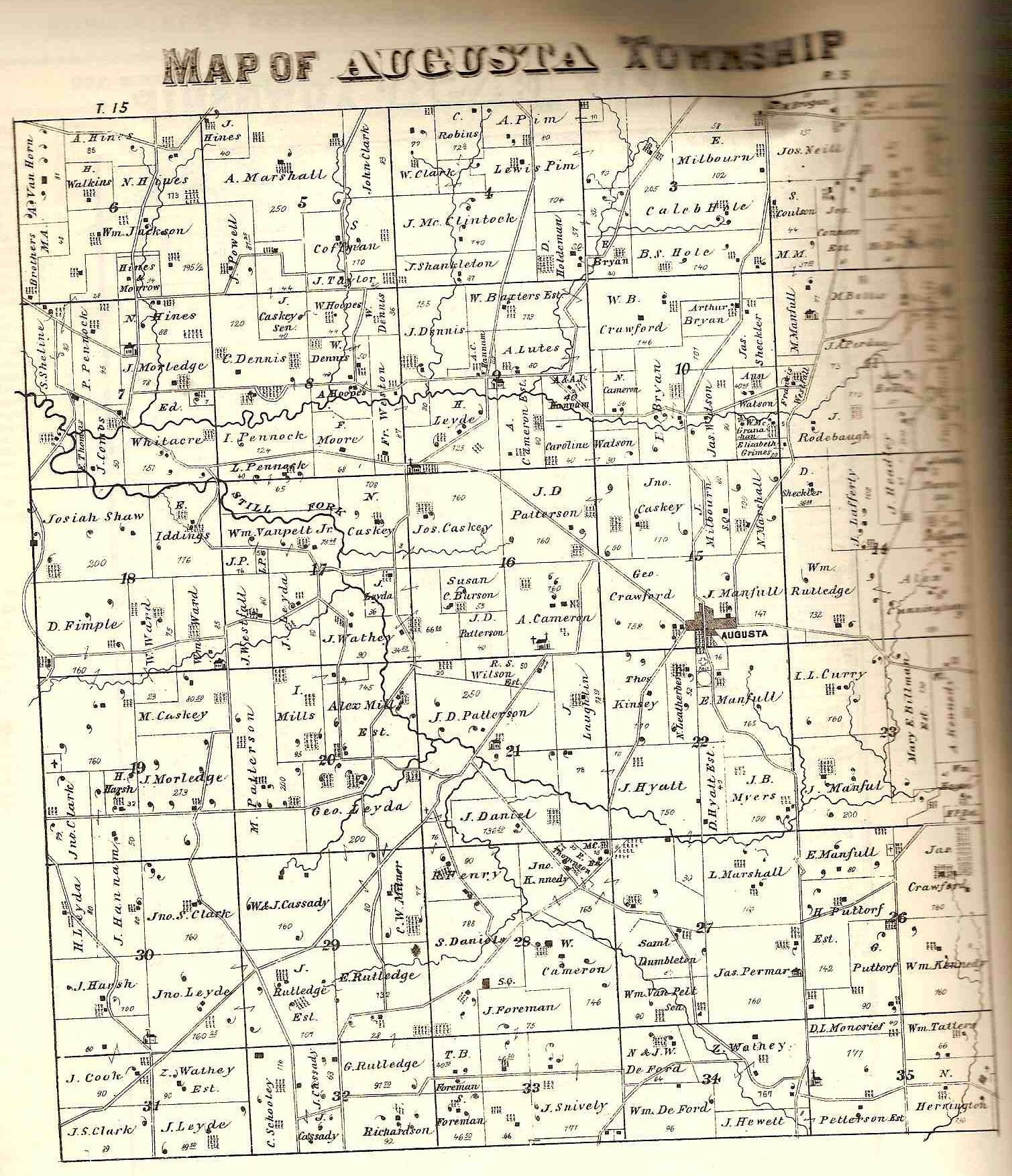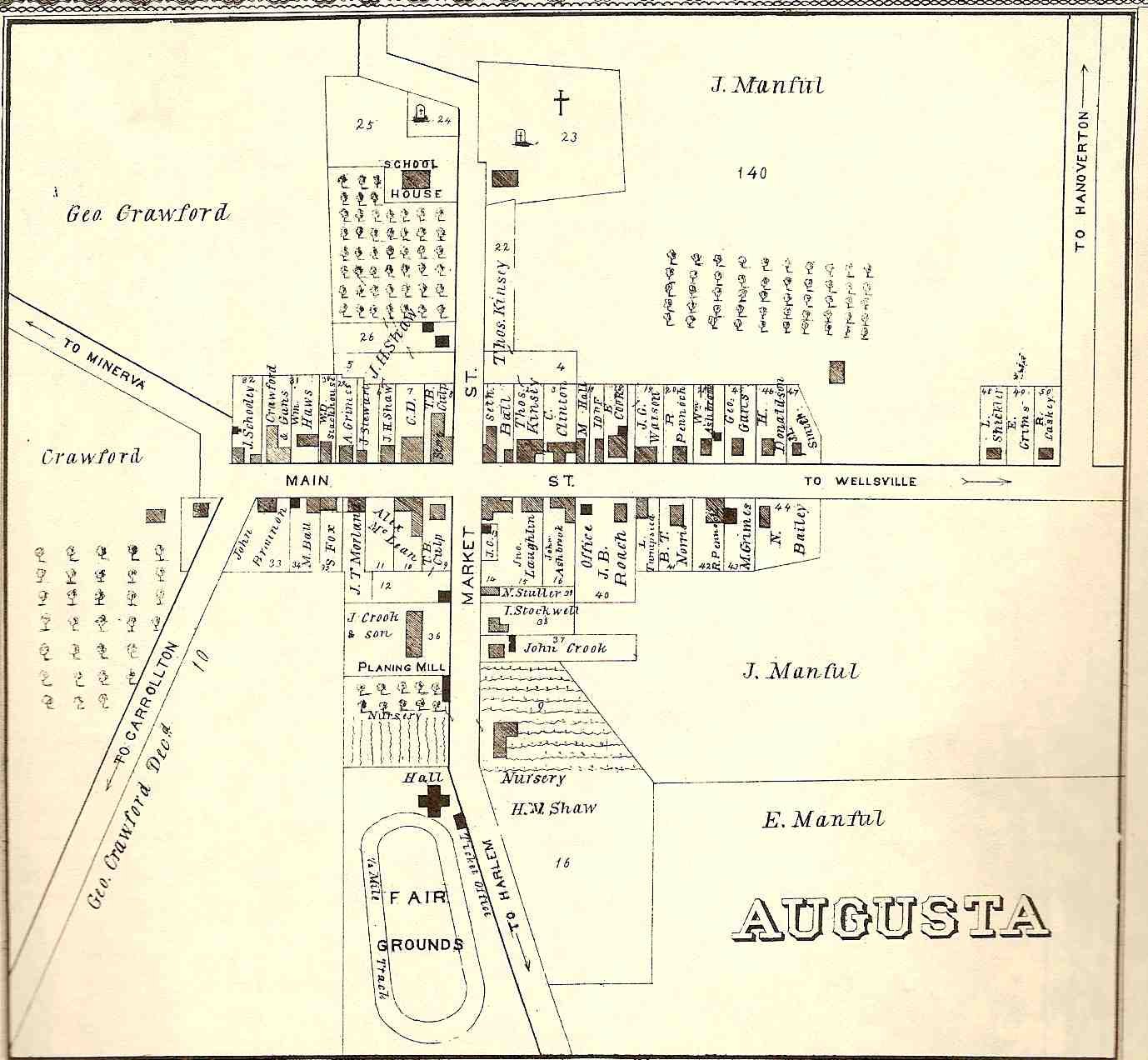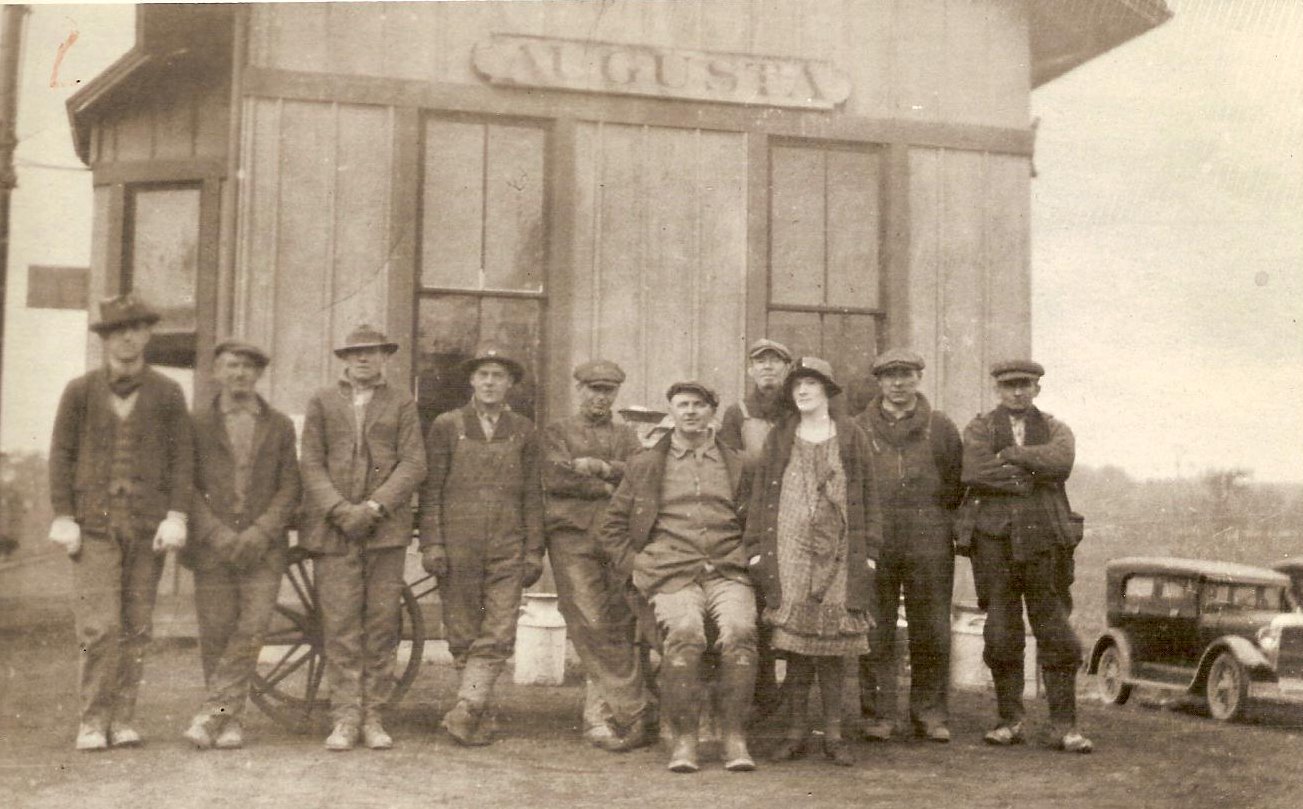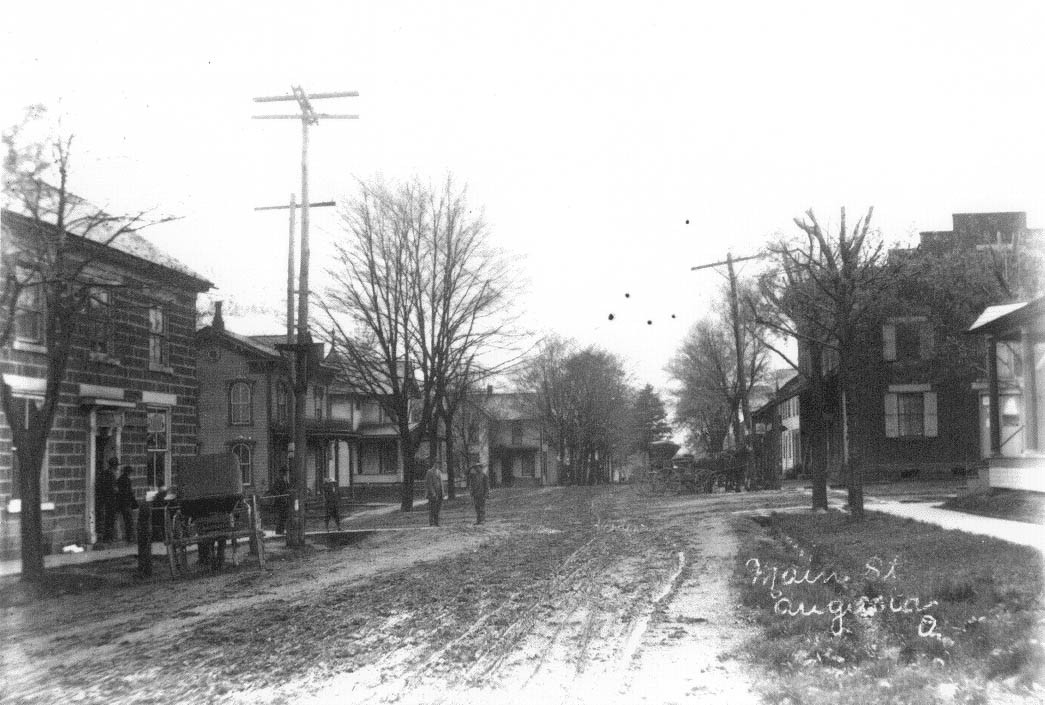by Taylor C. Woodward

AUGUSTA TOWNSHIP NO. 15 - RANGE 5

The land embraced within the limits of this township, together
with East, Fox, Washington, and that part of Center which was taken from Washington
Township, was a contribution of Columbiana County, at the formation of Carroll County
by the Ohio Legislature in the winter of 1832-33. The present civil township
of Augusta does not embrace all of the original surveyed township No. 15, in Range
5, by one row of sections 1, 12, 13, 24, 25, and 36 on the east side which were
taken off Augusta and added to East Township by the commissioners after the formation
of the new county.
The present township of Augusta contains but 30 sections, while an original surveyed
township contains 36 sections, or 23,040 acres. Brown, Fox and Rose are the
only townships that have not been changed from the original survey.
This is probably the route Frederick Post, the Moravian Missionary and Captain Pipe traveled over in 1761, after the Delaware chief's invitation to him to visit his people at the Indian village on the Muskingum River. After visiting the Indians and building a house on the north side of the river near the present town of Bolivar, in Tuscarawas County, which is said to be the first house built in Ohio, by white men, he then returned to Pennsylvania.
The next spring, in 1762, he, with a young missionary by the name of John Heckewelder, returned to the house he had built the year before, they having brought seeds to plant a garden with them, cleared a plot of ground and planted the first garden made in Ohio. They came here in the hope of starting a Mission, but it ended in failure.
The early settlers of Augusta Township came from Pennsylvania, Virginia, and Maryland, and the surrounding counties, many of them were of Irish descent, some English, many German, a few Swiss, and many of mixed descent. These courageous pioneers all faced with the problem of surviving in this new country, which was mostly all a wilderness.
Their first need was a shelter to protect them from the weather, which they made by building a lean-to of poles, making this do until time permitted building a log cabin. The next problem was getting enough grain and seeds planted to make food for the next year.
The first few years of the early pioneers' life in the new country was the most difficult of all. It is almost unbelievable what they accomplished with the tools and equipment they had, which were so crude compared to what we have today.
The corn was dropped by hand and covered with a hoe, oats and wheat broadcast by hand and harrowed in. Oats and wheat cradled or cut with a sickle, raked and bound by hand, then grain threshed out by hand with a flail or tramped out with horses. Many years later, the thresher run by horse power came into use.
Apples, potatoes, and vegetables would be kept in a cave or buried in the ground to keep them from freezing, in the winter. Many apples and peaches were dried and sold or kept to use.
A few of the early settlers were jack of all trades and master of most. They were carpenter, stone mason, brick layer, made their own shoes from leather they had tanned, brooms from broom-corn they had raised, maple syrup from the sugar tree, candles from the tallow, etc.
Wood was the only fuel of which the pioneers had plenty. Chopping wood was a daily chore in the winter. Wood choppings were very common in pioneer times. When anyone would put up a new building, his neighbors would all come in and help with the raising.
Salt was an essential needed by all in curing their meat, seasoning their food, and for their livestock. In early times salt was scarce, costing $5.00 or more a barrel to get from the east. In 1809, the first salt well was put down near Salineville, Columbiana County. A short time later, more wells were drilled and by the 1820's, salt could be purchased there. Shortly after the end of the Civil War, in the late 1860's, salt was made at a well near Lisbon, Columbiana County, which had been drilled for oil. Instead of oil, they struck gas and salt water. changing their plans, they went to making salt, using the gas for fuel in boiling down the salt water, and made up to 30 barrels a day. Some of the farmers of that day made an annual trip with their horses and wagons to the salt works near Lisbon and bought enough salt for the coming year.
Our pioneer farmer had very little market for any of his surplus wheat nearer than the Ohio River. After the Ohio Canal was completed, he might haul his wheat to Massillon, Bolivar, or other canal ports, taking two days to make the trip and receive $1.00 per bushel if the price was good.
Several of our early settlers had the ingenuity to take advantage of nature's power by damming up a creek and using water power to run machinery. In the early history of Augusta Township, there have been at least eight mills run by water power.
No. 1, a saw mill 3/4 mile up Reed's Run from State Route 9. No. 2, a saw mill one-half mile S.W. of Stillfork Creek, near S.R. 9. No. 3, a grist mill one-half mile up Twp. Rd. 256, from County Rd. 43. No. 4, an up and down saw mill, near where Twp. Rd. 251 joins Co. Rd. 43. No. 5, a grist mill one-half mile up stream near T.R. 251. When they quit using the building as a grist mill, they turned it into a stillhouse, and went to making whiskey. No. 6, a grist mill at Cat-fish Pond on Stillfork Creek. No. 7, an up and down saw mill one-fourth mile up Twp. Rd. 466 from Co. Rd. 44. No. 8, a grist mill near the cross roads of Co. Rd. 43 and 30, this was later changed to a saw mill.
A yoke of oxen on a tread mill furnished the original power to run one of our early grist mills. The author of this has seen a large Holstein bull running a tread mill, which furnished power to run a cream separator for one of the early Augusta Township dairymen. Dogs have been used on small tread mills to run churns and small machines. Much water has been pumped by wind wheels in Augusta Township. Steam power soon crowded out water power for heavy machinery. Then gasoline engines, in all sizes came into use and could be used to run anything from a washing machine to an ensilage cutter.
Tractors started to come into use in the early 1920's, mostly on steel and as they slowly improved and changed to rubber tires, they gradually crowded out the horses and mules on many of the farms. All other farm machinery has kept improving as time goes by, and many new labor saving machines have been invented.
Of all the improvements and inventions, electricity has benefited the rural people the most. Many 32 volt home light plants were in use in the early 1920's and a few with 110 volt current, but not until the R.E.A. took over, did many of them get electricity.
Geologists tell us almost all of Ohio, of which Augusta Township is a part, show signs of having been formed, grown, or deposited in and under water, which at that time, would be the Gulf of Mexico, which extended almost to the Great Lakes. The soil having been formed by the aging of the rocks, except the low areas along creeks, which are clay, as no glacial drift crossed the Tuscarora Trail in this township to cover the rocks, an abundant supply of stone covered most of the ground when the pioneers settled here. As many of these stones had to be removed when they plowed the ground, many would make stone fences out of them, which were quite numerous at one time. Much of the stone of this section were of a quality that could be formed into most any shape and was used to build houses (of which Augusta Township has many), stone walls, etc.
Around the year 1900 and before, there was a tax called a poll tax. Each male citizen between the age of 21 and 65 years old was assessed $3.00 per year with the privilege of working this out on the road at $1.50 per day or $3.00 if he brought his team and worked with them. Some would put their team to a road grader with one or two others and make ditches along the sides of the road. Others would take their team and wagon and haul stone from a field to the road where others would break up the stone in bad places in the road. Many stone fences were hauled out on the road in this manner to improve the roads. A road supervisor, appointed by the trustees, was always on the job to O.K. it.
There was a law several years before, that made it the duty of each board of township trustees to set aside $50.00 each year to build and keep up watering troughs along the public highways, for the benefit of horses.
In the early history of Augusta Township, we find most of the population receiving their mail at Augusta, except the ones living around the border, who were closer to the surrounding towns.
|
|
With the establishing of the Rural Free Delivery mail routes in February, 1902 and later, which delivered mail to the major portion of the rural population being one of the greatest improvements to that time, and appreciated by all. Mail was delivered with horses or mules to a cart, buggy, or mail wagon, until automobiles came into use several years later, and the roads had been much improved.
About this time, the telephone came into use in Augusta Township, first with an experimental line or two, then they hooked up with the Bergholz Company. The Eastern Ohio Company built a main line from East Rochester to Augusta first, then branched out from this line, charging each subscriber $1.00 per month. The Farmer's Line was also organized about the same time, with headquarters at Pattersonville, with each party building and maintaining his own line.
About the year 1906, autos started coming into the township and Augusta Township citizens have had their share of pleasure and grief with their Tin Lizzies, Puddle Jumpers, Willies-Knight, White-Steamers, Metz, etc.
One of Augusta Township's young men of that day, by the name of Johnson Crawford, rode the first motor cycle into the city of Toledo, Ohio. It was a French monstrosity, made in Paris. The cops arrested him and took him to headquarters. When they went to fine him, they could not find anything in the books to fine him for, then they requested him to take them for a ride and show them what it would do.
Dairy products always were one of the major products of Augusta Township, during the early years. Several of the families in the township were of Swiss descent, the majority of them being good dairymen, and some of them the finest cheese makers. A cheese factory was built in Muddyfork Valley, by A. & L. Cunningham, where a high grade of Swiss cheese was made in the years 1884-85 and 86, then it discontinued operation.
In 1887, Alex Cunningham built a cheese factory east of Augusta, one mile or more on County Road 18, at one of the best springs in the locality, where John Tritten and others made a fine grade of Swiss cheese for several years. About this period, another cheese factory was in operation a short distance east of this at Kennedy's Mill, and operated by Gotleib Zumbrunnen, another good cheese maker.
|
|
Finally, a few of the milk haulers bought trucks, which they could use in the summer. Most of these had solid tires and were chain driven. As autos and trucks increased in number, so did the talk for better roads. They kept improving a strip here and there, but it was not until about 1928, when Route 9 was put through, then they followed up by improving the secondary roads.
Augusta Township is not only noted for its dairy products, but, it has had and has at the present time, some of the best breeders of beef cattle. Its Black Angus, Hereford, and Shorthorn are known far and near, and our 4-H youths have taken their share of the blue ribbons, not only on livestock, but on all other lines.
Before trucks came into use, quite often cattle would be driven to market. Scales were located at Augusta, where they might be weighed. One well known stock buyer, A. Bryan, made many trips to Wellsville, hiring two boys to help drive the cattle. They would be met at Highlandtown by others, who would take over from there on.
Much wool was produced in this township, at one time. Cattle have now replaced many of the sheep. Much of the wool was sold at Augusta. The author of this has seen many wagon loads of fleeces of wool pitched, one fleece at a time, by a man in the wagon, to a man in the door of the second floor of the Crawford Brothers store, at that time, where it was weighed and sold.
Much fruit and berries have been grown in Augusta Township in the past. Old record show that four berry growers of near Augusta, shipped 600 bushels of strawberries, the year 1893. A basket factory was in operation at this time, in Augusta. Berries, at that time were hauled to Kensington and shipped on the train. The younger generation is still keeping up the tradition. At least two nurseries have been located in this vicinity in the past, the Henry Shaw Nursery, and the Nathaniel Marshall Nursery.
In 1949, a Volunteer Fire Department was organized in Augusta Township, and a fire truck purchased with donations and otherwise, the township trustees furnishing a place to keep it.
As many of the older generation had moved away, and some had passed away, and new faces had taken their places, and the ones left were not showing as much interest in the Homecomings as in the past, the Volunteer Fire Department took over, and with the cooperation of all, and the untiring efforts of the younger generation, have had an annual strawberry festival ever since, to help support the department, which has done a wonderful job, in taking care of all fires, and all members should be complimented for their services so willingly contributed.




